
Rodolphe Bresdin was a French draughtsman and engraver, born in Le Fresne-sur-Loire on 12 August 1822, who died in Sèvres on 11 January 1885.

Rodolphe Bresdin was a French draughtsman and engraver, born in Le Fresne-sur-Loire on 12 August 1822, who died in Sèvres on 11 January 1885.
His fantastic works, full of strange details, particularly attracted Charles Baudelaire, Théophile Gautier, Joris-Karl Huysmans, Robert de Montesquiou and André Breton. Odilon Redon was his pupil. Bresdin influenced contemporary artists like Jacques Moreau, George Rubel, Jean-Pierre Velly, and Philippe Mohlitz. Bresdin's life story and his art are both extraordinary and fascinating. He was one of the finest and most original exponents of the art of print-making in the nineteenth century and his name ranks alongside those of Whistler, Doré and Meryon in achievement and influence.
Huysmans described in his beautifully written, arresting novel À rebours ('Against Nature', alternative translation, 'Against the Grain') how his aesthete hero, Des Esseintes, 'in search of the rarest perfumes of visual splendours', has just savoured the prints of Jan Luyken, 'an old Dutch engraver almost unknown in France' :
"In the adjoining room, the vestibule, a larger apartment panelled with cedar wood the colour of a cigar box, were ranged in rows other engravings and drawings equally extraordinary.
Bresdin's 'Comedy of Death' was one, where an impossible landscape bristling with trees, coppices and thickets taking the shape of demons and phantoms, swarming with birds having rat's heads and tails of vegetables, from a soil littered with human bones, vertebrae, ribs and skulls, spring willows, knotted and gnarled, surmounted by skeletons tossing their arms in unison and chanting a hymn of victory, while a Christ flies away to a sky dappled with little clouds; a hermit sits pondering, his head between his hands, in the recesses of a grotto; a beggar dies, worn out with privations, exhausted with hunger, stretched on his back, his feet extended towards a stagnant pool."
Another was 'the Good Samaritan' by the same artist, an immense pen and ink drawing lithographed, a wild entanglement of palms, service trees, oaks, growing all together in defiance of seasons and climates, an outburst of virgin forest, crammed with apes, owls and screech owls, cumbered with old stumps shapeless as roots of coral, a magic wood, pierced by a clearing dimly revealing far away, beyond a camel and the group of the Samaritan and the men who fell by the wayside, a river and behind it again a fairy-like city climbing to the horizon line, rising to meet a strange-looking sky, dotted with birds, woolly with rolling clouds, swelling as it were, with bales of vapour.
You would have thought it the work of an early Italian master or a half-developed Albert Dürer, composed under the influence of opium.' ('Against the Grain', New York: Dover, 1971, p. 59)
Huysmans' description, although brilliantly conveying the mystique of Bresdin's work, does not fully do justice to the profundity of it. He only refers to two works, whereas Bresdin produced one hundred and forty etchings, twenty lithographs and a number of pen and ink drawings difficult to estimate.
Bresdin was, in part, a product of the Breton countryside with its sagacious, bardic folklore traditions, later beloved of Gauguin and his circle, and in part a refugee from the Paris Bohemia of Henri Murger with its dolorous, witty intonations. His portrayals of the household interiors of the rural poor show uncanny empathy with their inhabitants and rapport with the imaginative hinterland of their psyches. His series of the Holy Family's flight to Egypt was highly praised by Redon, who thought it Bresdin's best work, and by de Montesquiou. His depictions of nature, showing its seductive charm alongside its underlying menace are unique and some time spent with these works can change one's whole way of seeing the natural world.
Bresdin's life story is as dramatic and iconic as those of Van Gogh and Gauguin. It has the ingredients of a great Hollywood epic: childhood in the Breton countryside; a family row leaving him homeless in Paris and becoming part of the bohemian milieu with Charles Baudelaire, Henri Murger and Victor Hugo; after the counter revolution walking 678 kilometres to Toulouse; living in the open air, workmen's and fishermen's huts; taking a wife and six children to Canada in pursuit of the dream of 'living off the land'; rescued and brought back to France by Hugo and the bohemian writers and artists; separation from the family and death in a garret room in Sèvres.

Charles-Marie-Georges Huysmans was a French novelist and art critic who published his works as Joris-Karl Huysmans. He is most famous for the novel À rebours. He supported himself by way of a 30-year career in the French civil service.

Symbolism was a late 19th-century art movement of French and Belgian origin in poetry and other arts seeking to represent absolute truths symbolically through language and metaphorical images, mainly as a reaction against naturalism and realism.

Jules-Amédée Barbey d'Aurevilly was a French novelist, poet, short story writer, and literary critic. He specialised in mystery tales that explored hidden motivation and hinted at evil without being explicitly concerned with anything supernatural. He had a decisive influence on writers such as Auguste Villiers de l'Isle-Adam, Henry James, Leon Bloy, and Marcel Proust.
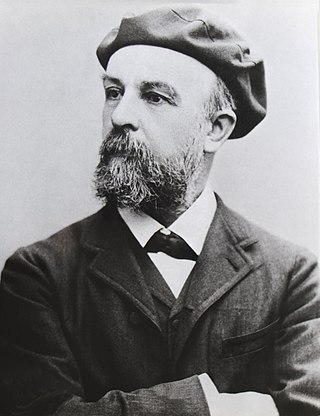
Odilon Redon was a French Symbolist artist.

Félicien Victor Joseph Rops was a Belgian artist associated with Symbolism, Decadence, and the Parisian fin de siècle. He was a painter, illustrator, caricaturist and a prolific and innovative print maker, particularly in intaglio. Although not well known to the general public, Rops was greatly respected by his peers and actively pursued and celebrated as an illustrator by the publishers, authors, and poets of his time. He provided frontispieces and illustrations for works by Jules Barbey d'Aurevilly, Charles Baudelaire, Charles De Coster, Théophile Gautier, Joris-Karl Huysmans, Stéphane Mallarmé, Joséphin Péladan, Paul Verlaine, Voltaire, and many others. Best known today for his prints and drawings illustrating erotic and occult literature of the period, he also produced oil paintings including landscapes, seascapes, and occasional genre paintings. Rops is recognized as a pioneer of Belgian comics.
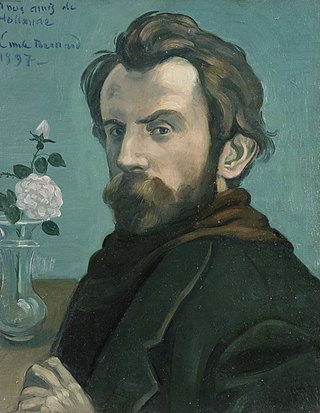
Émile Henri Bernard was a French Post-Impressionist painter and writer, who had artistic friendships with Vincent van Gogh, Paul Gauguin and Eugène Boch, and at a later time, Paul Cézanne. Most of his notable work was accomplished at a young age, in the years 1886 through 1897. He is also associated with Cloisonnism and Synthetism, two late 19th-century art movements. Less known is Bernard's literary work, comprising plays, poetry, and art criticism as well as art historical statements that contain first-hand information on the crucial period of modern art to which Bernard had contributed.
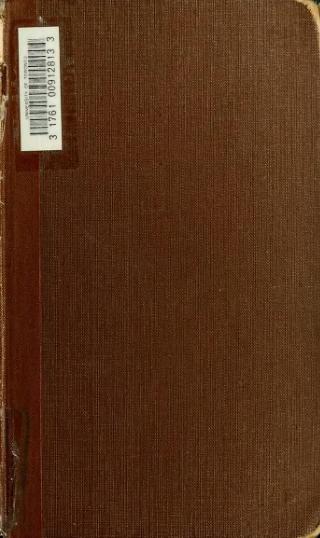
À rebours is an 1884 novel by the French writer Joris-Karl Huysmans. The narrative centers on a single character: Jean des Esseintes, an eccentric, reclusive, ailing aesthete. The last scion of an aristocratic family, Des Esseintes loathes nineteenth-century bourgeois society and tries to retreat into an ideal artistic world of his own creation. The narrative is almost entirely a catalogue of the neurotic Des Esseintes's aesthetic tastes, musings on literature, painting, and religion, and hyperaesthesic sensory experiences.

Henry de Groux was a Belgian Symbolist painter, sculptor and lithographer. His 1889 painting Christ attacked by a mob made when he was only 22 years old established his reputation as an innovative Symbolist painter and ensured his admission to the progressive artistic circles in Brussels. He spent most of his active career in Paris. He produced many works depicting the horrors of the First World War in the latter part of his career.
The Bouzingo were a group of eccentric poets, novelists, and artists in France during the 1830s that practised an extreme form of romanticism whose influence helped determine the course of culture in the 20th century including such movements as Bohemianism, Parnassianism, Symbolism, Decadence, Aestheticism, Dadaism, Surrealism, the Lost Generation the Beat Generation, Hippies, Punk rock, etc.

The Decadent movement was a late-19th-century artistic and literary movement, centered in Western Europe, that followed an aesthetic ideology of excess and artificiality.
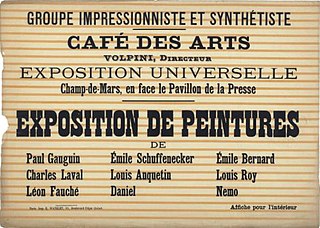
The Volpini Exhibition was an exhibition of paintings arranged by Paul Gauguin and his circle held at the Café des Arts on the Champ de Mars, not far from the official art pavilion of the 1889 Exposition universelle in Paris. A poster and an illustrated catalogue were printed, but the show of "Paintings by the Impressionist and Synthetist Group", held in June and early July 1889, was ignored by the press and proved to be a failure.
Robert André Edouard Baldick, FRSL, was a British scholar of French literature, writer, translator and joint editor of the Penguin Classics series with Betty Radice. He was a Fellow of Pembroke College, Oxford.

En rade is a novel by the French writer Joris-Karl Huysmans. It first appeared as a serial in the magazine Revue Indépendante between November 1886 and April 1887. It was published in book form on 26 April 1887 by Tresse et Stock. En rade followed Huysmans' most famous novel, A rebours, and was a commercial failure since neither critics nor the public could understand its mixture of brutal realism and fantasy. Later on, the Surrealists were more appreciative and André Breton included extracts from the novel in his Anthology of Black Humour.
Marthe, histoire d'une fille was the first novel by the French writer Joris-Karl Huysmans, published in 1876.
The year 1848 in France, like other European countries, is mostly remembered as the year of a revolution that deposed king Louis Philippe and brought Napoleon III to power as president of the second republic.

Marie Joseph Robert Anatole, comte de Montesquiou-Fézensac was a French aesthete, Symbolist poet, painter, art collector, art interpreter, and dandy. He is reputed to have been the inspiration both for Jean des Esseintes in Joris-Karl Huysmans' À rebours (1884) and, most famously, for the Baron de Charlus in Marcel Proust's À la recherche du temps perdu (1913–1927). Some believe that he may even have been used by Oscar Wilde in The Picture of Dorian Gray.

Auguste Brouet (1872–1941) was a French etcher and book illustrator.
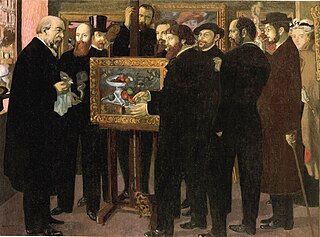
Homage to Cézanne is a painting in oil on canvas by the French artist Maurice Denis dating from 1900. It depicts a number of key figures from the once secret brotherhood of Les Nabis. The painting is a retrospective; by 1900 the group was breaking up as its members matured.

Théodore (Théo) Hannon (1851-1916) was a Belgian painter, watercolorist, engraver, and man of letters. As a man of letters, he was a scenarist, theatrical-parodist, and poet.

Francis Paul Édouard Adrien Poictevin was a French writer, dandy and novelist. Born to the banker Paul Poictevin in Paris, his novels amplified the processes of "artistic writing". He was a disciple of Edmond de Goncourt, friend and confident of Joris-Karl Huysmans, but turned more and more towards mysticism and madness. Forgotten, he was later strongly admired by Louis Aragon, Paul Éluard and André Breton.
This article includes a list of references, related reading, or external links, but its sources remain unclear because it lacks inline citations .(June 2024) |